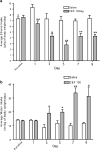Effects of ceftriaxone on ethanol intake: a possible role for xCT and GLT-1 isoforms modulation of glutamate levels in P rats
- PMID: 24687412
- PMCID: PMC4176549
- DOI: 10.1007/s00213-014-3545-y
Effects of ceftriaxone on ethanol intake: a possible role for xCT and GLT-1 isoforms modulation of glutamate levels in P rats
Abstract
Rationale: Evidence suggests that glutamate transporter 1 (GLT-1) and cystine/glutamate exchanger transporter (xCT) are critical in maintaining glutamate homeostasis. We have recently demonstrated that ceftriaxone treatment induced upregulation of GLT1 levels and attenuated ethanol intake; however, less is known about the involvement of xCT on ethanol intake. In this study, we investigated the effects of ceftriaxone on the levels of xCT in both continuous and relapse-like ethanol drinking, as well as GLT-1 isoforms, and glutamate aspartate transporter (GLAST) in relapse-like ethanol intake.
Methods: P rats received free choice of 15 and 30 % ethanol and water for 5 weeks and then deprived of ethanol for 2 weeks. Rats were treated with ceftriaxone (100 mg/kg, i.p.) or saline during the last 5 days of the 2-week deprivation period. After deprivation period, P rats were re-exposed to free choice of 15 and 30 % ethanol and water for nine consecutive days. A second group of P rats was given continuous ethanol access for 5 weeks, then ceftriaxone (100 mg/kg, i.p.) or saline throughout the week 6.
Results: Ceftriaxone significantly attenuated relapse-like ethanol intake. Importantly, this effect of ceftriaxone was associated in part with upregulation of the levels of GLT-1a and GLT-1b isoforms and xCT in the prefrontal cortex (PFC) and the nucleus accumbens (NAc). There were no significant differences in GLAST expression among all groups. We also found that ceftriaxone treatment increased xCT levels in both PFC and NAc in continuous ethanol intake.
Conclusion: These findings suggest that xCT and GLT-1 isoforms might be target proteins for the treatment of alcohol dependence.
Conflict of interest statement
Figures





Comment in
-
Potential dual role of cephalosporins in management of alcohol use disorders.Psychopharmacology (Berl). 2014 Dec;231(24):4745-6. doi: 10.1007/s00213-014-3788-7. Epub 2014 Nov 4. Psychopharmacology (Berl). 2014. PMID: 25363464 No abstract available.
References
-
- Anderson CM, Swanson RA. Astrocyte glutamate transport: review of properties, regulation, and physiological functions. Glia. 2000;32:1–14. - PubMed
-
- Backstrom P, Hyytia P. Ionotropic glutamate receptor antagonists modulate cue-induced reinstatement of ethanol-seeking behavior. Alcohol Clin Exp Res. 2004;28:558–565. - PubMed
-
- Bannai S, Ishii T. Transport of cystine and cysteine and cell growth in cultured human diploid fibroblasts: effect of glutamate and homocysteate. J Cell Physiol. 1982;112:265–272. - PubMed
-
- Bannai S, Christensen HN, Vadgama JV, Ellory JC, Englesberg E, Guidotti GG, Gazzola GC, Kilberg MS, Lajtha A, Sacktor B, et al. Amino acid transport systems. Nature. 1984;311:308. - PubMed
Publication types
MeSH terms
Substances
Grants and funding
LinkOut - more resources
Full Text Sources
Other Literature Sources
Medical
Miscellaneous

